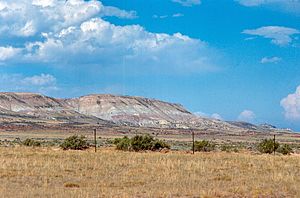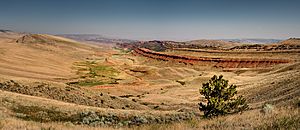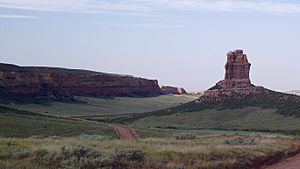List of National Natural Landmarks in Wyoming facts for kids
Wyoming is home to some amazing natural places, and six of them are so special they've been named National Natural Landmarks! These landmarks are chosen because they show important parts of Earth's natural history or have unique geological features. They are like natural museums, helping us understand how our planet was formed and changed over millions of years.
Contents
Discover Wyoming's Natural Landmarks
Wyoming's National Natural Landmarks include huge canyons, a giant wind-carved hollow, a fossil-rich cliff, and even a stream that splits to flow into two different oceans! Each one tells a unique story about our planet.
The Big Hollow
The Big Hollow is a giant, bowl-shaped area near Laramie. It was formed by strong winds that blew away soil and rocks over thousands of years. Imagine a huge natural scoop in the ground! This landmark shows how powerful wind can be in shaping the land. It was recognized as a National Natural Landmark in November 1980.
Como Bluff
Como Bluff is a famous ridge near Rock River. It's known for incredible fossil discoveries, especially from the late Jurassic period. This was a time millions of years ago when huge dinosaurs walked the Earth! Scientists have found many important dinosaur bones and other ancient life forms here. It became a landmark in May 1966 and again in November 1973.
Crooked Creek Natural Area
The Crooked Creek Natural Area is a special place in Big Horn County. It's a rich source of fossils from early Cretaceous period land animals. This means scientists can learn a lot about the creatures that lived here long, long ago. It was designated a landmark in 1966.
Red Canyon
Red Canyon is a beautiful canyon near Lander. It shows off many different layers of rock, like pages in a giant history book. These layers reveal how the Earth changed over time. The canyon also holds clues about human life from over 10,000 years ago! It became a landmark in November 1980.
Sand Creek
Sand Creek is located in Albany County. It features amazing examples of "cross-bedded sandstone" and "topple blocks." Cross-bedded sandstone looks like wavy layers of sand, showing how ancient winds or water moved. Topple blocks are huge pieces of rock that have fallen away from cliffs. This area is considered one of the best places in North America to see these formations. It was named a landmark in December 1984.
Two Ocean Pass
Two Ocean Pass is a truly unique spot in the Teton Wilderness. It sits right on the Continental Divide. This is the imaginary line that separates rivers flowing to the Pacific Ocean from those flowing to the Atlantic Ocean. At a place called Parting of the Waters, a stream called North Two Ocean Creek actually splits! One part flows into Pacific Creek, which eventually reaches the Pacific Ocean. The other part flows into Atlantic Creek, which makes its way to the Atlantic Ocean. It's an incredible example of how water can connect distant parts of the world. It became a landmark in October 1965.
Images for kids







